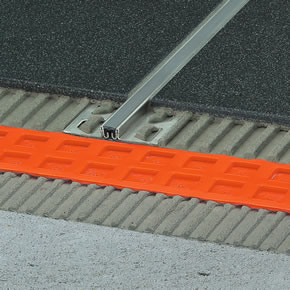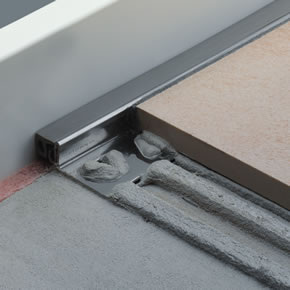
Movement joints developed to prevent damage to flooring
Schlüter explains how the correct specification of movement joints can prevent damage to tile coverings and stone flooring installations.
After installation, tile and stone flooring can often fail: variations in temperature and moisture can cause movement within subfloors, resulting in cracks. In some cases, this movement can weaken the bond between floor covering and substrate.
A lack of movement joints can be a contributing factor to failure. According to current industry standards and regulations, movement joints are required in all tile and stone installations to prevent such damage.
If an architect neglects to specify movement joints, they may be liable for any resulting problems; it is the responsibility of the architect to ensure that the appropriate type of joint is specified and installed in the correct location.
Specifying movement joints
 Movement joints must be designed at specification to ensure penetration through the tile and screed covering.
Movement joints must be designed at specification to ensure penetration through the tile and screed covering.
By understanding the types of movement that are likely to occur – such as moisture, thermal, structural and deflection movement, as well as dry shrinkage – architects will be able to specify a movement joint suitable for counteracting the resulting stresses.
In floors, there are two basic types of movement joints: structural and non-structural. Both will be subject to different movement patterns; they work to prevent damage differently.
The Schlüter-DILEX range of movement and expansion joints offers a range of solutions, suitable for all relevant movement joints in tile coverings.
Schluter-Systems
Units 3-5 Bardon 22
Beveridge Lane
Coalville
Leicestershire
LE67 1TE
UK
01530 813396
Visit the Schluter-Systems website
Visit Supplier's page
Latest news

17th April 2025
Nuaire shares expertise at Specifi Mechanical Services events in 2025
Indoor air quality and ventilation manufacturing specialist Nuaire is pleased to be exhibiting at the Specifi Mechanical Services events once again in 2025.
Posted in Air Conditioning, Articles, Building Industry Events, Building Industry News, Building Products & Structures, Building Services, Exhibitions and Conferences, Facility Management & Building Services, Heating, Ventilation and Air Conditioning - HVAC, Restoration & Refurbishment, Retrofit & Renovation
15th April 2025
West Fraser: CaberDek earns top marks from Home Counties carpentry specialist
A specialist carpentry sub-contractor covering housing sites across a large swathe of the Home Counties has come to value CaberDek from the West Fraser range for a variety of reasons: not least because the high quality panel product doesn’t destroy his operatives’ electric saws!
Posted in Articles, Building Industry News, Building Products & Structures, Building Systems, Case Studies, Restoration & Refurbishment, Retrofit & Renovation, Roofs, Timber Buildings and Timber Products, Wooden products
15th April 2025
GEZE: The Role of Access Control Systems in Enhancing Building Safety
Jane Elvins, Specification and Business Development Manager at GEZE UK, delves into the role of access control systems in enhancing building safety…
Posted in Access Control & Door Entry Systems, Architectural Ironmongery, Articles, Building Industry News, Building Products & Structures, Building Services, Doors, Facility Management & Building Services, Health & Safety, Restoration & Refurbishment, Retrofit & Renovation, Security and Fire Protection
11th April 2025
Don’t Do a Dave! It’s Time to Lock FIT Show 2025 in Your Calendar!
It’s that time again – FIT Show is back! You could be forgiven for thinking there won’t be much new to see when FIT Show returns to the NEC from 29 April – 1 May. Wrong!
Posted in Articles, Building Industry Events, Building Industry News, Building Products & Structures, Building Services, Continuing Professional Development (CPD's), Exhibitions and Conferences, Information Technology, Innovations & New Products, Restoration & Refurbishment, Retrofit & Renovation, Seminars, Training
 Sign up:
Sign up: